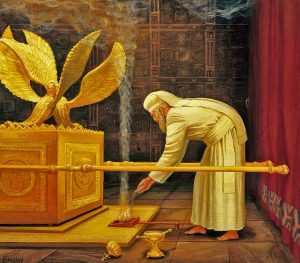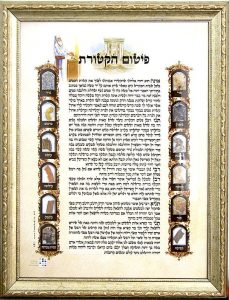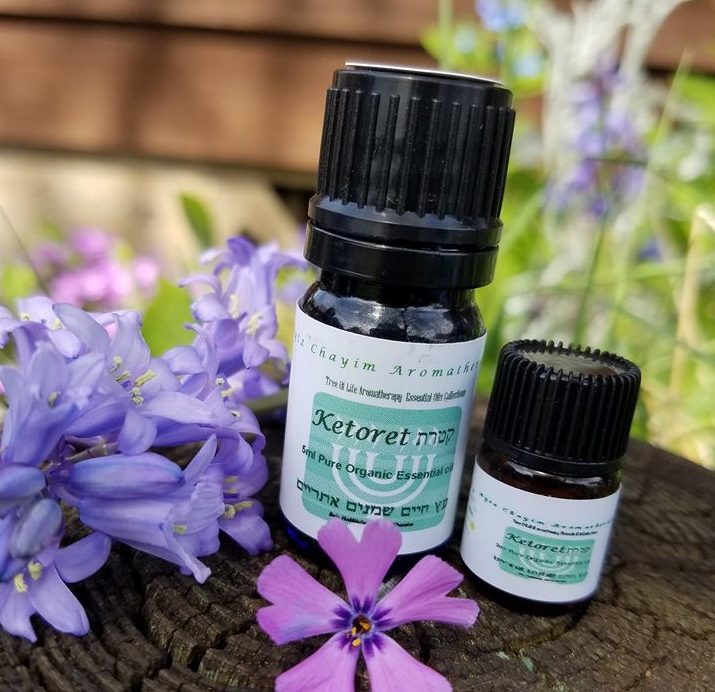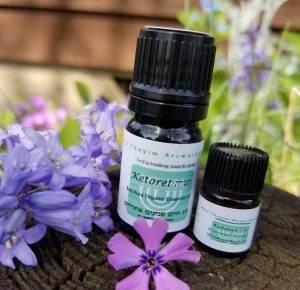Incense, Evil Thoughts and Repentance
Can the scent and aroma of incense cause one to repent? Does it help purge evil thoughts? Can bad thoughts and behavior, if you chap, be fought by lighting up some incense? We shall explore those questions below.
Welcome to parshas Ki Sisa which, though efsher most well known for the eygel caper -the Yiddin, having miscalculated when Moishe was to return from his meeting with the RBSO, and thinking he was dead, went on to build a golden calf- the parsha also contains a number of other most interesting topics and laws including the rules of conducting a census, the building of the sink used to wash the Kohanim’s hands and feet, a strict reminder to observe and keep the heylige shabbis, as well as others. Because we no longer have a mizbayach (altar) and Temple services, and because we no longer bring korbonis (animal sacrifices), mistama you glanced over a number of, or all of, the pisukim that address the consecration of the kohanim, the various vessels that were part of the Mishkan, the anointing oils, and the kitoires. The kitoires? What the hec are they and what does the heylige Toirah tell us about them? Ershtens: kitoires are incense, and it appears that the RBSO very much loves the scent of incense. He does? Says who and where? Nu, to chap how the aroma of the kitoires could satisfy the RBSO and also have an indelible affect on man, we need to begin our review (our 9th of this parsha) by learning a few pisukim innavening (by reading the text). Believe me, most of you have never thought about these words. Ober, before we do, let’s go back one parsha and learn one critical posik. Says the heylige Toirah (Shemois 30:7), azoy:
| 7. Aharon shall make incense of spices go up in smoke upon it; every morning when he sets the lamps in order, he shall make it go up in smoke. | זוְהִקְטִ֥יר עָלָ֛יו אַֽהֲרֹ֖ן קְטֹ֣רֶת סַמִּ֑ים בַּבֹּ֣קֶר בַּבֹּ֗קֶר בְּהֵֽיטִיב֛וֹ אֶת־הַנֵּרֹ֖ת יַקְטִירֶֽנָּה: |
 So critical and important was the burning of the incense, that Aharoin the Koihen Godol (High Priest) was instructed to burn the kitoires on the special altar -the Mizbayach Hazohov (Golden Altar) used just for that very purpose- twice a day. As an aside, the kitoires were also offered three times on the day of Yom Kippur. Ober what exactly were the kitoires? How were they made? Prepared? What were its ingredients? In what proportions? And why were they so important to the RBSO? Did the RBSO give Moishe an ingredients list? Shoin, to chap how all this worked, how the scent of the Kitoires could also help those who had evil thoughts and were otherwise sinners -think of yourselves by way of example, if you chap- let us also read a few pisukim (verses) from this week’s parsha. Says the heylige Toirah (Shemois 30: 34-38), azoy:
So critical and important was the burning of the incense, that Aharoin the Koihen Godol (High Priest) was instructed to burn the kitoires on the special altar -the Mizbayach Hazohov (Golden Altar) used just for that very purpose- twice a day. As an aside, the kitoires were also offered three times on the day of Yom Kippur. Ober what exactly were the kitoires? How were they made? Prepared? What were its ingredients? In what proportions? And why were they so important to the RBSO? Did the RBSO give Moishe an ingredients list? Shoin, to chap how all this worked, how the scent of the Kitoires could also help those who had evil thoughts and were otherwise sinners -think of yourselves by way of example, if you chap- let us also read a few pisukim (verses) from this week’s parsha. Says the heylige Toirah (Shemois 30: 34-38), azoy:
| 34. And the Lord said to Moishe: “Take for yourself aromatics, [namely] balsam sap, onycha and galbanum, aromatics and pure frankincense; they shall be of equal weight. | לדוַיֹּ֩אמֶר֩ יְהֹוָ֨ה אֶל־משֶׁ֜ה קַח־לְךָ֣ סַמִּ֗ים נָטָ֤ף | וּשְׁחֵ֨לֶת֙ וְחֶלְבְּנָ֔ה סַמִּ֖ים וּלְבֹנָ֣ה זַכָּ֑ה בַּ֥ד בְּבַ֖ד יִֽהְיֶֽה: | |
| 35. And you shall make it into incense, a compound according to the art of the perfumer, well blended, pure, holy. | להוְעָשִׂ֤יתָ אֹתָהּ֙ קְטֹ֔רֶת רֹ֖קַח מַֽעֲשֵׂ֣ה רוֹקֵ֑חַ מְמֻלָּ֖ח טָה֥וֹר קֹֽדֶשׁ: | |
| 36. And you shall crush some of it very finely, and you shall set some of it before the testimony in the Tent of Meeting, where I will arrange meetings with you; it shall be to you a holy of holies. | לווְשָֽׁחַקְתָּ֣ מִמֶּ֘נָּה֘ הָדֵק֒ וְנָֽתַתָּ֨ה מִמֶּ֜נָּה לִפְנֵ֤י הָֽעֵדֻת֙ בְּאֹ֣הֶל מוֹעֵ֔ד אֲשֶׁ֛ר אִוָּעֵ֥ד לְךָ֖ שָׁ֑מָּה קֹ֥דֶשׁ קָֽדָשִׁ֖ים תִּֽהְיֶ֥ה לָכֶֽם: | |
| 37. And the incense that you make, you shall not make for yourselves according to its formula; it shall be holy to you for the Lord. | לזוְהַקְּטֹ֨רֶת֙ אֲשֶׁ֣ר תַּֽעֲשֶׂ֔ה בְּמַ֨תְכֻּנְתָּ֔הּ לֹ֥א תַֽעֲשׂ֖וּ לָכֶ֑ם קֹ֛דֶשׁ תִּֽהְיֶ֥ה לְךָ֖ לַֽיהֹוָֽה: | |
| 38. Any person who makes anything like it, to smell it[s fragrance], shall be cut off from his people. | לחאִ֛ישׁ אֲשֶׁר־יַֽעֲשֶׂ֥ה כָמ֖וֹהָ לְהָרִ֣יחַ בָּ֑הּ וְנִכְרַ֖ת מֵֽעַמָּֽיו: |
From the text we learn the following: Moishe was told to take fragrances such as balsam, onycha, galbanum and frankincense, all in the same amounts. He then added 7 more spices for a total of 11. Note that only four ingredients of the mix are mentioned. Three of them just after the word “samim” meaning spices or aromatics (as used above in verse 34) – as in more than one, followed again by the word “samim” before the fourth ingredient is mentioned. We’ll come back to these words in a moment. Ober, didn’t the Oisvorfer mention (just above) that the kitoires formula contained a total of 11 spices? He did! How did Moishe know to find additional spices and which other seven were needed to create the kitoires mix? Not to worry: The heylige Gemora (Kirisus 6A and 6B) had the same question and our Sages, based on the exact wording of the posik, concluded that though only four are mentioned, there were more. Says the heylige Gemora: “the compounding of the kitoires involved the following substances.” The Gemora then lists all 11 spices which include: atacte, onycha, galbanum and frankincense. Myrrh, cassia, spike-lavender, saffron, costus, aromatic bark and cinnamon. Ober, how did the heylige Gemora know which spices were required if the heylige Toirah did not tell us? Not to worry! Says the Gemora (Kirisus 6b), azoy: “It was communicated to Moishe at Sinai that 11 spices were to be used in the Kitoires.” No wonder Moishe was late in coming down. How the hec was he going to remember all this information?
 And they concluded this how and why? Says Rav Huna: Because that word “samim” appears twice in the verse. So what? How does that repetition of the word ‘samim’ get us to 11 spices when only 4 are mentioned by name? Let’s find out by making believe we are back in yeshiva and thinking logically as does the heylige Gemora. Nu, since the Toirah mentions “samim,” a word meaning several, we must conclude that there were at least two different spices in the mix. And given that the word “samim” appears before the next three ingredients are listed by name, we already have five. At least two from the word ‘samim’ and the three that follow. Veyter and fantastic. And since the word “samim” appears again, we need to now double the number we had before. And since we had five before, we add another five. That makes 10. And since another ingredient is mentioned by name -the frankincense, after we already have 10, we now have 11. What could be better? Creative accounting for sure but hey, it’s not like the Gemora was reporting these numbers to the SEC in a public filing. Shoin, and just like that, our sages concluded that there were 11 different aromatic spices needed to prepare the kitoires.
And they concluded this how and why? Says Rav Huna: Because that word “samim” appears twice in the verse. So what? How does that repetition of the word ‘samim’ get us to 11 spices when only 4 are mentioned by name? Let’s find out by making believe we are back in yeshiva and thinking logically as does the heylige Gemora. Nu, since the Toirah mentions “samim,” a word meaning several, we must conclude that there were at least two different spices in the mix. And given that the word “samim” appears before the next three ingredients are listed by name, we already have five. At least two from the word ‘samim’ and the three that follow. Veyter and fantastic. And since the word “samim” appears again, we need to now double the number we had before. And since we had five before, we add another five. That makes 10. And since another ingredient is mentioned by name -the frankincense, after we already have 10, we now have 11. What could be better? Creative accounting for sure but hey, it’s not like the Gemora was reporting these numbers to the SEC in a public filing. Shoin, and just like that, our sages concluded that there were 11 different aromatic spices needed to prepare the kitoires.
Interestingly enough, we are taught that of the 11, 10 gave off a sweet aroma, ober one of the ingredients, the Chelbeno (galbanum), did not. It gave off a foul and pungent odor. Oib azoy (if so) why was the chelbeno included among the 11? Are we not taught that the key function of the kitoires (incense) offering was its fragrance? We were! The purpose of the kitoires offering was to produce a “rayach nichoiach” (satisfying aroma) before the RBSO and taka so says the heylige Toirah (Bamidbar 28:2). And says the heylige Gemora (Brochis 43B), azoy: “what is it that gives enjoyment to the soul and not the body? That is fragment smell.” Moreover, says Shlomo Hamelech in Mishlay (Proverbs 27:9): “oil and incense rejoice the heart.” Why then include the foul smelling and pungent odor emitting galbanum? What purpose did it serve? Many an exegete had the same question and let’s see what they had to say about the role this unique foul smelling spice played in the entire Kitories process.
Though the entire order of the kitoires is found in our sidurim (prayer books), in recent years, Toirah inspired entrepreneurs have sprung up and started printing and selling a separate booklet, also featured in leather-bound format, which contains the entire text of the kitoires on parchment. Known by its name of ‘Pitum Hakitoires,’ many have been, and continue to be purchased and used. Ober, why are people buying this stand-alone parchment when it’s offered free of charge in our sidurim? What about its text has so many enraptured? Is it the leather cover? The parchment? What is so special about the recitation of the kitoires? Are its words magical?
 Says the Medrish (Tanchuma), azoy: among all the sacrifices offered in the Mishkan when it stood, and the Temples when they stood, none was as special to the RBSO as was the kitoires (incense) offerings. And he knows this how? As proof, the medrish (May’am Loez) tells us azoy: the altar upon which all animals sacrifices were offered stood outside the Tabernacle, just before its entrance. Ober the incense altar, the much smaller altar but fashioned of gold, upon which only the kitoires (incense) offering was brought, stood inside the Tabernacle just in front of the holy ark. The RBSO wanted the aroma nearby. Another reason offered for the importance of the incense offering goes azoy: unlike all other sacrifices which were offered to atone for one’s sins (of which there were many and korbonis were brought daily and all day long to accommodate the long lines of sinners), the incense offering, was only offered to express joy, to bring joy to the RBSO who truly enjoys the sweet aroma from the combination of the sweet spices being offered.
Says the Medrish (Tanchuma), azoy: among all the sacrifices offered in the Mishkan when it stood, and the Temples when they stood, none was as special to the RBSO as was the kitoires (incense) offerings. And he knows this how? As proof, the medrish (May’am Loez) tells us azoy: the altar upon which all animals sacrifices were offered stood outside the Tabernacle, just before its entrance. Ober the incense altar, the much smaller altar but fashioned of gold, upon which only the kitoires (incense) offering was brought, stood inside the Tabernacle just in front of the holy ark. The RBSO wanted the aroma nearby. Another reason offered for the importance of the incense offering goes azoy: unlike all other sacrifices which were offered to atone for one’s sins (of which there were many and korbonis were brought daily and all day long to accommodate the long lines of sinners), the incense offering, was only offered to express joy, to bring joy to the RBSO who truly enjoys the sweet aroma from the combination of the sweet spices being offered.
Ober what about that one ingredient, the chelbeno, the (galbanum) which gave off a rather foul pungent odor? Didn’t its inclusion among the other ten spices diminish the sweet smell of the kitoires designed to give off a sweet and pleasant aroma directly to the RBSO? Why taka was it included?

Said Reb Chana b. Bizna in the name of Rav Chisda, azoy: A public fast in which none of the sinners of Israel participate, is not a fast. What did he say, and how is this related to our question? What has galbanum to do with public fasting? The answer lies in the rest of his statement which tells us azoy: “….for behold, the odor of galbanum is unpleasant, and yet it was included among the spices for the kitoires (incense offering). And? Now we need to explore further. A review of what several exegetes had to say reveals the following: when the chelbeno with its foul odor was included in the spice mix, and though the chelbeno, as a stand-alone spice, gave off a foul and unpleasant odor, when combined with the other 10 sweet smelling spices, it had a role to play. Perhaps a very significant one. Perhaps its inclusion worked to further stimulate the other fragrances to release their own sweet aromas. The chelbeno was efsher the catalyst that pushed the other spices to give off their sweet aromas. Maybe the aroma was that much sweeter, ver veyst? Hec, the Oisvorfer’s eishes chayil sprinkles salt onto watermelon and insists that the watermelon is even sweeter as a result.
And its connection to public fasting and sinners? Said the good rabbi, azoy: the inclusion of sinners among otherwise good people does not diminish the quality of the good guys. Perhaps their participation helps, and makes the prayers of the others that much better and accepted. Efsher the metaphorical foul odor emanating from the sinner -in terms of his/her bad behavior- helps those good guys by encouraging better behavior and more meaningful prayer. In plain English: efsher the lesson of the galbanum is to not look askance, not to mistreat, not to discourage or attempt to distance, those we consider sinners. Farkert (opposite is true): perhaps, it’s the tafkid (charge) of the Yiddin to encourage those who are not yet penitents, to include, vs. exclude, those who seem different, or are. Those whose behavior we condemn. Who are we to judge and to diminish the value sinners bring to the mix? Efsher it’s our job to davka (specifically) include them and encourage them through such inclusion. And says the Ran: it’s taka a form of reverse psychology when there is meaningful interaction between the good, the virtuous, and the sinners. Efsher the sinner does not look like you, dress like you or talk like you. Nonetheless, chelbeno teaches us to be kind, nice, and encouraging. Efsher the RBSO looks at many of us as His chelbeno. He knows we are bad, ober keeps around anyway. Those who consider themselves righteous and yet chase away those whom they consider sinners, those whom they consider foul, are but hypocrites, and it’s their prayers which require further inspection. Having a beard and side curls is simply not enough. It must be accompanied by behavior and actions the RBSO finds pleasing and aromatic.
Says the heylige Zoihar (the great mystic with whom the Oisvorfer does not argue), azoy: the kitoires was an enlightened remedy which helped purify the people from sin. The sweet fragrances emanating from the mizbayach while the incense was being offered, would stir sinners to repentance. Hearts would be purified of all evil thoughts and from defilement of any evil urges one had been harboring. Shoin: In the absence of the Temple and its offerings, in our times, we recite the verbiage our sages put together in the prayer known as Pitum Hakitoires. If recited with kavono (a healthy degree of seriousness and introspection), the prayers alone, give us protection. Protection is avada good, if you chap, and especially so when harboring evil thoughts.
Just today, in response to a question I posed, one gentleman who recites the kitoires from a parchment ensconced in leather, one chusid (chasiddic Jew) told the Oisvorfer that it bring about “big things.” What those big things were, he did not know. Evil thoughts also bring about big things, if you chap. Moments later, when the Oisvorfer asked another chusid the same question, he was told azoy: “I heard of this custom (to recite the kitoires from a parchment) but my grandfather did not do so, neither did my father. And that’s good enough for me.” He continued: “none of the great rebbes I knew or read about recited kitoires off a parchment.” The bottom line: If reciting the kitoires off parchment wrapped nicely in a leather-covered booklet sold as a separate item, the protection offered by its recitation, is likely more expensive but provides the same result.
Should we by burning incense in our own homes? Can the sweet aroma of incense burning bring us joy and help stir our minds?
A gittin Shabbis-
The Heylige Oisvorfer Ruv
Yitz Grossman

